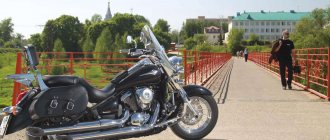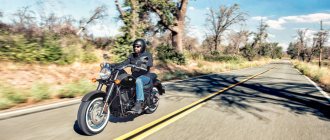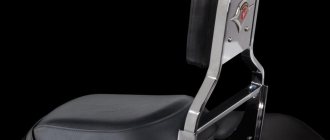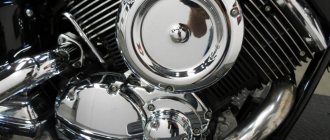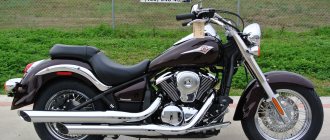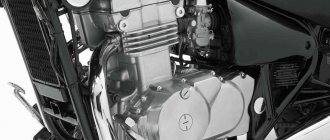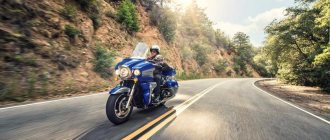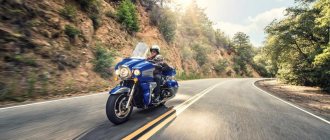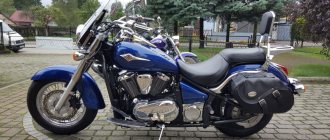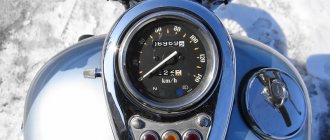Real competitors
At the time of its appearance, only the American Harley-Davidson could compete with the model, but three years later Yamaxa presents its answer - the V-Star 950 version.
Harley-Davidson Street 750.
Yamaxa V-Star 950.
Cruisers of a similar class were also produced by other Japanese, but “the middle weight category is just beginning with the 900cc model. If you’re going to do it, it’s just liters,” so Kawasaki had no real competitors in this class .
The model is still in production, like previous versions, it has several modifications, excellent driving performance, traditional Japanese reliability and design in the style of a classic American cruiser.
Video
Kawasaki VN 1500 Vulcan
- a heavy cruiser made in a classic style, extremely popular all over the world. The model goes back to the 80s, being a descendant of the VN-15 modification, which featured an engine and a 4-speed transmission. In 1996, the outdated predecessor was replaced by the new Vulcan, which was noticeably different from the previous model and was produced in four different versions. Strictly speaking, there were five versions - there was also a Kawasaki Mean Streak, but it has little in common with the classic Vulcan, and a separate article is devoted to it. And so on the market you can see four different Vulcans that rolled off assembly lines from 1996 to 2004. The most common Kawasaki Vulcan 1500 Classic, the standard version with spoked wheels and one brake disc on the front wheel. Following it was the Classic Tourer version, which featured alloy wheels, a different size front wheel, a different exhaust, plenty of chrome, as well as pre-installed panniers and a windshield. The Kawasaki Vulcan 1500 Nomad version is similar to the Classic Tourer, but has a larger fuel tank to 19 liters, hard plastic panniers painted in the color of the motorcycle, and two brake discs on the front wheel. The fourth version of the Vulcan, the Kawasaki Vulcan 1500 Drifter, stands completely apart - it is a motorcycle stylized as the legendary Indian with deep wings, a unique saddle and an injector. The Kawasaki Vulcan 1500 engine has excellent performance at low speeds (peak torque occurs at 2800 rpm) and produces 54 hp and 112 nm of torque. All motorcycles were equipped with a liquid-cooled V-twin, a cardan drive and a 5-speed transmission. Since 2002, motorcycles equipped with injectors have gone into production. The maximum speed of the VN 1500 is about 180 kilometers per hour, but a comfortable cruiser without vibrations and increased gas consumption is no more than 140 kilometers per hour.
Massive and heavy, this cruiser handles surprisingly well. Of course, its large mass (from 290 to 335 kg depending on the version) requires certain physical characteristics from its rider, but, nevertheless, the Kawasaki Vulcan 1500, by the standards of the class, handles really well, calmly turning up to the footrests in steep turns. The low-revving engine allows you to start sharply, although it runs out of steam once you reach the upper third of the rev range. The brakes, of course, could be better - they are clearly not enough for such a heavy motorcycle. The situation is somewhat better only with the Kawasaki Vulcan 1500 Nomad modification due to two brake discs at the front, while the rest of the brakes are somewhat lacking. However, the shiny chrome and growling exhaust cruiser is more conducive to a non-aggressive and relaxed ride than to racing on city streets. The suspension of all modifications of the Kawasaki Vulcan 1500 is classic - a telescopic fork at the front and two shock absorbers at the rear. However, according to reviews from some owners, it is characterized by excessive softness, which may not always be appropriate on Russian roads, since it sometimes “breaks through” in potholes, especially if the motorcycle is loaded with a couple of people and luggage. But what the VN 1500 cannot be denied is comfort. Of the four, the Kawasaki Vulcan 1500 Nomad is best suited for the role of a touring motorcycle - a larger gas tank (19 liters versus 16) and excellent standard panniers are a great help on long trips. When driving slowly at a cruising speed of 120 km/h, fuel consumption does not exceed 6.5 liters per hundred kilometers, and the engine readily digests AI-92, although it is very picky about the purity of gasoline.
We can say that the Kawasaki Vulcan 1500 is a typical cruiser in the good sense of the word. Big, beautiful, with a typical chopper engine, it will certainly appeal to fans of this style. Of course, its size, weight and power require that the rider has a good amount of experience before riding the VN 1500, but it’s not for nothing that this bike has such a huge following. It has much more advantages than disadvantages.
Specifications
Engine – left view.
Engine – right side view.
As a rule, a cruiser offers a sedate ride, no matter in the city or on the highway, so the engine of the new Vulcan did not receive any special technological solutions. However, the injector, as well as KDTV , a patented power management system were carried over from Kawasaki sports models.
Taking this and some other developments into account, the result is a rather interesting hybrid.
Options:
- working volume - 903 cm3;
- number of cylinders - 2;
- number of cycles - 4;
- number of valves - 8, 4 per cylinder;
- power - 50 (48) hp;
- torque - 82 (78) Nm;
- cooling - liquid;
- fuel supply - injector;
- ignition - transistor (TDI);
- start - electric starter;
- tank volume - 20 l.
In 2013, new environmental standards were adopted. In order not to close production, the engine was reconfigured. New indicators are in parentheses.
KDTV
The motorcycle is equipped with the revolutionary Suzuki Dual Throttle Valve fuel injection system.
Kawasaki Dual Throttle Valves system largely replicates similar systems from other Japanese manufacturers. For example, SDTV from Suzuki. A pair of throttle valves in the intake valves.
One is connected to the gas handle via a regular cable, the second is controlled by a servo drive. The only difference between this system and its analogues is the different diameters of the channels. Under the servo drive - less.
Transmission and clutch
A distinctive feature of the 900 Vulcan is its belt drive, which is lighter than a drive shaft and requires less maintenance than a classic chain.
Like any other cruiser, the Vulcan has a 5-speed gearbox . It works excellently , shifts clearly, and the pedal travel is also within acceptable limits. To find the neutral, engineers used an unusual solution. The neutral itself is in the standard place, between the first and second, to activate it you just need to “throw” the paw up. Special protection will block the move higher, after which neutral will be activated and the corresponding indicator on the tank will turn on.
- The standard clutch is multi-disc, oil bath . Power transmission is a cable .
- But the main drive is made in the style of American cruisers - with a belt drive .
Brakes
There is nothing special about the braking system either. Conventional discs with 2-piston hydraulic support.
Front brakes.
Rear brakes.
Front:
- number of disks - 1;
- diameter - 300 mm;
- support - 2-piston.
Rear:
- number of disks - 1;
- diameter - 270 mm;
- support - 2-piston.
No options are offered.
Brief history of the model
Model
: Kawasaki Vulcan 1700 Classic;
Kawasaki Vulcan 1700 Classic Tourer (Nomad); Kawasaki Vulcan 1700 Classic LT; Kawasaki Vulcan 1700 Voyager / ABS (North America, Europe, Australia). Factory designation
: VN1700E9F; VN1700C9F; VN1700G9F; VN1700A9F, VN1700B9F (ABS).
Model
: Kawasaki Vulcan 1700 Classic / ABS;
Kawasaki Vulcan 1700 Classic Tourer ABS (Nomad); Kawasaki Vulcan 1700 Classic LT; Kawasaki Vulcan 1700 Voyager / ABS (North America, Europe, Australia). Factory designation
: VN1700FAF, VN1700EAF; VN1700DAF, VN1700CAF; VN1700GAF; VN1700AAF, VN1700BAF (ABS).
Model
: Kawasaki Vulcan 1700 Classic / ABS;
Kawasaki Vulcan 1700 Classic Tourer ABS (Nomad); Kawasaki Vulcan 1700 Voyager / ABS; Kawasaki Vulcan 1700 Vaquero (Voyager Custom) / ABS (North America, Europe, Australia). Factory designation
: VN1700FBF, VN1700EBF; VN1700DBF, VN1700CBF; VN1700ABF, VN1700BBF (ABS); VN1700JBF, VN1700KBF.
Model
: Kawasaki Vulcan 1700 Classic / ABS;
Kawasaki Vulcan 1700 Classic Tourer ABS (Nomad); Kawasaki Vulcan 1700 Voyager / ABS; Kawasaki Vulcan 1700 Vaquero (Voyager Custom) / ABS (North America, Europe, Australia). Factory designation
: VN1700FCF, VN1700ECF; VN1700DCF, VN1700CCF; VN1700ACF, VN1700BCF (ABS); VN1700JCF, VN1700KCF.
Model
: Kawasaki Vulcan 1700 Classic / ABS;
Kawasaki Vulcan 1700 Classic Tourer ABS (Nomad); Kawasaki Vulcan 1700 Voyager / ABS; Kawasaki Vulcan 1700 Vaquero (Voyager Custom) / ABS (North America, Europe, Australia). Factory designation
: VN1700FDF, VN1700EDF; VN1700DDF, VN1700CDF; VN1700ADF, VN1700BDF (ABS); VN1700JDF, VN1700KDF.
Model
: Kawasaki Vulcan 1700 Classic ABS;
Kawasaki Vulcan 1700 Classic Tourer ABS (Nomad ABS); Kawasaki Vulcan 1700 Voyager / ABS; Kawasaki Vulcan 1700 Vaquero ABS (Voyager Custom ABS) (North America, Europe, Australia). Factory designation
: VN1700FEF; VN1700DEF; VN1700AEF, VN1700BEF (ABS); VN1700KEF.
Model
: Kawasaki Vulcan 1700 Classic Tourer ABS (Nomad ABS);
Kawasaki Vulcan 1700 Voyager ABS; Kawasaki Vulcan 1700 Vaquero ABS (Voyager Custom ABS) (North America, Europe, Australia). Factory designation
: VN1700DFF; VN1700BEF; VN1700KFF.
Model
: Kawasaki Vulcan 1700 Classic Tourer ABS (Nomad ABS);
Kawasaki Vulcan 1700 Voyager ABS; Kawasaki Vulcan 1700 Vaquero ABS (Voyager Custom ABS) (North America, Europe, Australia). Factory designation
: VN1700DGF; VN1700BGF; VN1700KGF.
Model
: Kawasaki Vulcan 1700 Voyager ABS;
Kawasaki Vulcan 1700 Vaquero ABS (Voyager Custom ABS) (North America, Australia). Factory designation
: VN1700BHF; VN1700KHF.
Model
: Kawasaki Vulcan 1700 Voyager ABS;
Kawasaki Vulcan 1700 Vaquero ABS (Voyager Custom ABS) (North America, Australia). Factory designation
: VN1700BJF; VN1700KJF.
Model
: Kawasaki Vulcan 1700 Voyager ABS;
Kawasaki Vulcan 1700 Vaquero ABS (Voyager Custom ABS) (North America). Factory designation
: VN1700BKF; VN1700KKF.
Model
: Kawasaki Vulcan 1700 Voyager ABS;
Kawasaki Vulcan 1700 Vaquero ABS (Voyager Custom ABS) (North America). Factory designation
: VN1700BLF;
VN1700KLF.
Driving performance,
Nobody expects racing characteristics from a cruiser, so the manufacturers did not particularly boost the engine. The maximum speed of the bike is 169 km/h .
The situation is the same with acceleration - in 6.92 seconds from 0 to 100 km/h.
Fuel consumption
The developers are especially proud of fuel consumption.
The stated figure is 4.8 liters per 100 km for the combined cycle. The final result depends on the riding style, modification of the motorcycle and the capabilities of the pilot. However, by definition, it is impossible to “fry for all the money” on a cruiser.
Video
Kawasaki VN 400 Vulcan
— a typical representative of small-capacity choppers. It is not for nothing that it is popular among novice motorcyclists - it is not too expensive, weighs little, and looks stylish. The VN 400 model exists in two versions - Classic and Drifter. Let's take a closer look at each of them. From a technical point of view, however, there are few differences between the 400 cc Kawasaki Vulcans. The Kawasaki VN 400 Vulcan Classic (pictured above) is a classic cruiser. Massive and leaning toward retro style, it embodies the classics of the American school of motorcycle building. However, its Japanese origin is revealed by the immediately noticeable radiator installed in the front of the frame. But deep fenders, wide seats, a horned steering wheel and a large, bulbous headlight hint that this is a representative of the old school. The Kawasaki VN 400 Vulcan Drifter is a very rare motorcycle, due to the fact that it was produced in very limited quantities. Externally, it copies the immortal American classic represented by Indian motorcycles - very deep fenders, a unique exhaust, a large 50s-style saddle raised above the motorcycle.
But the excellent handling characteristic of the entire Kawasaki Vulcan line is really pleasing - here the VN 400 is at its best. Outwardly massive and clumsy, it behaves surprisingly obediently on the road even during sharp maneuvers, and with some skills it even steers into turns up to the footrests. The gas tank of the Kawasaki VN 400 also traditionally pleases with its volume, which is 15 liters. Taking into account the moderate appetite of the motorcycle, consuming an average of 4 liters per 100 km of road, this provides it with a more than solid power reserve of more than three hundred kilometers. It is worth noting that the Kawasaki Vulcan 400 is a very comfortable motorcycle. It has large dimensions for a 400 cc bike, larger than many of its classmates in terms of cubic capacity, so we can safely say that it will not be cramped even for a fairly tall motorcyclist. And at the same time, the competent arrangement of components, which has shifted the center of gravity down, makes the Kawasaki VN 400 Vulcan quite easy to operate even for beginners, and this motorcycle is very good as a chopper for a girl.
However, don’t let the number “400” in the name fool you. The Kawasaki VN 400 Vulcan looks and behaves like a real adult motorcycle. It is perfect for both short trips and everyday driving to work or for evening rides from bar to bar. In addition, they usually ask for quite reasonable money for VN 400, and this is also an important plus.
Dimensions and weight
Typically, the user imagines a cruiser as something large, massive, and heavy. Kawasaki VN900 Vulcan decided not to break traditions.
Externally, the motorcycle is perceived as a large touring bike, while its engine capacity is less than a liter.
Curb weight, depending on modification, is from 275 to 300 kg .
It is also similar in size to a cruiser, with the exception of the Custom model, which can be called a stripped-down version:
- length - 2,465 (2,405) mm;
- width - 1,005 (894) mm;
- height - 1,054 (1,120) mm;
Seat height - 680 (685) mm .
Wheelbase - 1,646 mm .
Custom dimensions in brackets. The difference in height is explained by the fact that the wheels on the Custom are 5 inches larger ...
For whom is it intended?
A variety of modifications allows drivers of any height to choose the most suitable option.
- In the case of a road bike, a low saddle suggests comfort only for short bikers.
- In the case of a cruiser, comfort is provided to bikers of short and medium height.
In the case of the Vulcan, convenience is offered to all. 4 modifications will allow you to choose a bike that is convenient for a specific owner.
Comfort
Firstly, it’s worth talking about the noise level. This one is small, thanks to the belt drive. This distinguishes the Kawasaki VN 1700 Vulcan from many other representatives of the brand.
As a result, when changing gears, there are no various clanging and other unpleasant sounds that certainly accompany chain drives and cardan shafts.
Secondly, the motorcycle does not fall over when cornering, even at low speeds, which makes it convenient for city yards
It is important to note the quality of the materials from which the seat is made.
However, there is also a drawback. The instrument panel is inconvenient to look at due to the fact that it is located low. However, this is also what makes for great design. This is not to say that this is a big minus.
From many first-person videos it is clear that if desired, the driver will not have any difficulty looking at the panel. It's just not as convenient as on many other models. But definitely nothing will interfere with the view.
As for the speedometer, everything is not clear. Miles are poorly distinguishable, but kilometers, on the contrary, are well distinguished. So comfort here depends directly on what country the owner of the motorcycle lives in. But, of course, it would be better if all the speedometer readings were clearly visible.
Modifications and competitors
In 2006, in parallel with the Vulcan Ckassic, the Classic LT (Light Tourer) . A year later, production of the Vulcan Custom begins. Another fourth modification, the Vulcan Classic Special Edition (SE), was produced on individual orders. Basically this was the basic version, but with a different color and slightly modified performance characteristics.
Kawasaki VN900 Vulcan Classic.
Kawasaki VN900 Vulcan Classic Special Edition.
Kawasaki VN900 Vulcan Custom.
Kawasaki VN900 Vulcan Light Tourer.
Stock modifications included:
- Kawasaki VN900 Vulcan Classic - spoked wheels, large footrests. Engine cover and exhaust pipes in chrome. Wide, comfortable seat for two passengers.
- Kawasaki VN900 Vulcan Light Tourer . The Ckassic body kit added a high windshield, side saddlebags (leather!), and a backrest for the second number. Due to the LT glass, the maximum height is 1480 mm .
- The Kawasaki VN900 Vulcan Custom features regular footpegs, minimal chrome, and a single-person saddle. Cast wheels of increased diameter.
- Kawasaki VN900 Vulcan Classic Special Edition (SE) - special order with a choice of colors. The basic version is black and white.
As already mentioned, the bike had no real competitors.
Yamaha V-Star 950
The model was intended primarily for the American market, which is why the emphasis was placed on an air vent motor.
The Yamaha V-Star 950 had the following differences:
- 942 cm3;
- air cooling;
- digital ignition;
- 1 piston on the rear disc.
Externally, the model was also offered in 2 versions, equivalent to Vulcan Ckassic and Vulcan Classic LT..
Among the Americans, several competitors could be named. The most striking was the Harley-Davidson Softail Deluxe/Fat Boy . The release continues .
Exterior
Kawasaki Vulcan motorcycles have an impressive design, they can be recognized among hundreds of other motorbikes by their chrome wheel arches, single-sided exhaust pipes and futuristic seat shapes. The main difference between the Vulcan is its rapid contours, creating the impression of a “cheetah in a jump,” which is enhanced by the sloping rear shock absorbers and the elongated rear wing.
Peculiarities
Users identified only a few details as features:
- the main drive is a belt drive in the American style;
- non-standard, as for a cruiser, angle of inclination of the front fork.
Simple telescopic fork with 135 mm travel.
Flaws
Users find few disadvantages:
- 5-speed gearbox - while driving you want to engage sixth, but the transmission doesn’t have it!
- brakes - for a tank weighing 300 kg, emergency braking by the standard system only with wheel locking and skidding...
In the first years of production, the model was withdrawn from sale several times, returning to the factory for revision. The reasons were in the fuel system and generator . Owners of motorcycles from recent years of production do not voice such problems.
Advantages
Sitting on the bike is very comfortable – the transition from the driver’s “seat” to the passenger “stool” creates comfortable support for the lower back.
But the strongman clearly has more advantages.
- Large set of parts for tuning . Despite the 3 modifications in the Vulcan model range, there are windows of different heights, roll bars, various additional lights, handbags and much more.
- Well-thought-out ergonomics make the bike almost universal - for bikers of any height and build.
- Low fuel consumption . For extra-urban use no more than 4 liters .
- Controllability.
- Maneuverability.
- Fuel gauge on the instrument panel.
The instrument panel is located on the tank, as is customary for motorcycles of this class.
A low center of gravity is a plus for some, a minus for others.
The lineup
In just thirty years of successful production of the Kawasaki Vulcan motorcycle, nine models were created and mass-produced:
- "Kawasaki Vulkan-750", 1984-2006.
- "Kawasaki Vulkan-400", 1986-2004.
- "Kawasaki Vulkan-500", 1990-2009.
- "Kawasaki Vulkan-1500", 1987-2008.
- "Kawasaki Vulkan-800", 1995-2006.
- "Vulcan-1600", 2002-2009
- "Kawasaki Vulkan-2000", 2004-2010.
- "Vulcan-900", from 2006 to the present.
- "Kawasaki Vulkan-1700", from 2009 to the present.
The entire model range of the Kawasaki Vulcan motorcycle was produced in the classic version of a cruise bike, with comfortable seats, comfortable shock absorption and smooth gear shifting. All these characteristics correspond to two-wheeled vehicles designed for long trips.
Links[edit | edit code]
- Avro Vulcan Bomber Tribute Page
- Vulcans in Camera
- Vulcan Test Pilot Role Falk history
- Building the Vulcan a 1957 Flight
article
| Avro aircraft | |
| By brand name |
|
| By purpose | Bombers 730 Aldershot Antelope Buffalo Lanceln Manchester Vulcan Transport and Lancastrian York Sea Patrol Anson Shackleton Passenger 748 ASHTONAMMODORE EIGHTERE EIGHTEEN FIVE SIX TEN SIX UDOR Educational and training 504 ATHENA CADET PREAFET TUTOR AVOCET spider Sports Avian Baby Experimental 707 Ashton Burga Duigan Early Roe I Biplane Roe I Triplane Roe II Triplane Roe III Triplane Roe IV Triplane |
Engine
The engine of the car is characteristic - it has two cylinders and four strokes, and its type is in-line. Why characteristic? Kawasaki in the Vulcan series has long used mainly a V-shaped version, but it was decided that this kind of engine would be more suitable.
This motor provides great capabilities. Just look at the acceleration alone: the bike can reach a speed of 100 kilometers per hour in just 4.2 seconds. Those who are familiar with the series will understand that this is a very high figure for Vulcan. In addition, the motorcycle is superior to bikes from many other brands in this regard.
The maximum speed of the car is 175 kilometers per hour. This is a good indicator for a cruiser, and allows us to talk about it as a fast motorcycle, especially taking into account its acceleration. Such successes of the model are explained by serious indicators of power and torque.
At its peak, the torque of Vulcan C is 63 newton meters. This figure is achieved at 6600 rpm. In terms of power at maximum level, the engine reaches 61 horsepower at 7500 rpm. The engine displacement is 649 cubic centimeters. These characteristics allow the motorcycle to remain one of the fastest cruisers in its weight category.
